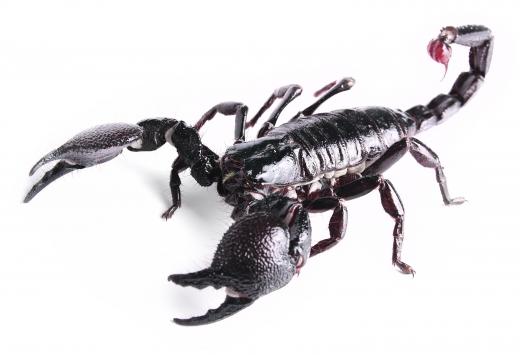What are Eurypterids?
 Michael Anissimov
Michael Anissimov
Eurypterids, also known as sea scorpions, are an extinct class of arthropods that were related to modern-day marine chelicerates such as horseshoe crabs and spiders. Eurypterids grew from a few inches to the huge Jaekelopterus, which reached 2.5 m (8.2 ft) or more in length and competes with the Carboniferous myriapod (centipede-relative) Arthropleura for the title of largest arthropod of all time. A typical eurypterid was only 20 cm (8 in) in size, however. 200 fossil species are known.
Eurypterids existed for almost half the total duration of known multicellular life, from approximately 510 to 251 million years ago. In contrast, mammals have only existed for only about half that time, and dinosaurs a little more than half. Because they emerged almost at the beginning of the Paleozoic era and died out at the end, eurypterids are considered an iconic Paleozoic organism. Eurypterids went extinct during the Permian-Triassic extinction, the most severe mass extinct in Earth's history. From a evolutionary biologist's point of view, the death of the eurypterids might be considered the end of the success of large arthropods in earthly ecosystems.

Eurypterids superficially resemble modern scorpions, to which they are related. Instead of having a curving stinger at their ends, they had a long spine which probably didn't play much of a role in hunting. Like in horseshoe crabs, it probably helped the animal maneuver through the water and was also used to correct itself if it flipped over.
There is no evidence that eurypterids were venomous. Some had claws, but the more primitive eurypterids just used their feeding parts, chelicerae, to obtain food. Sometimes these chelicerae are casually called "claws," however. Eurypterids had a strong carapace connected to paddles which were used for swimming and/or digging. Under their carapace, they had four legs for scuttling along. Eurypterids had small, simple eyes for locating prey.
Instead of swimming through the water like some other predators, eurypterids mostly crawled along the bottom. Rare as fossils, eurypterids mostly lived in brackish water or lagoons rather than the open sea. As they often lived near land, it has been speculated that eurypterids may have spent part of their life cycle on land (a fact supported by the discovery of terrestrial track fossils from the Cambrian, a time period where it is commonly thought there was no terrestrial life besides microbes).
Eurypterids are thought to have consumed fish and other arthropods such as crustaceans. Their chelicerae exhibit a fine branching structure which would have helped them gather numerous small food particles, like a filter feeder.
AS FEATURED ON:
AS FEATURED ON:











Discussion Comments
@pleonasm - Unfortunately it's the same story with any fossil find. There are, no doubt thousands of species which never made it into the fossil record for whatever reason, or that maybe we've never found.
It sounds like these guys were around for a long time, long enough to have evolved in plenty of different directions. The different sizes that have been found are proof of that.
Although, it's not clear whether those different sizes indicate different sub-species or different stages in growth for the same species.
After all, most fish and arthropod species now start off very small and can get quite large over time. It wouldn't really stretch the imagination to think that the 20cm specimens are the baby brothers of the 2.5meter specimens.
I imagine there would always be a lot more of the smaller ones to find as well, since they'd be much more likely to perish.
@KoiwiGal - There are a few fish even today which are able to spend relatively long periods out of the water. The mud skipper for example.
They use different methods of doing so, from the equivalent of holding their breath, to having pseudo-lungs as well as gills. If they lived in brackish water that probably helped them develop the capacity to breath both salty and fresh water, so maybe breathing air as well wasn't that much of a leap.
Unfortunately it's pretty difficult to tell exactly what was going on with their internal organs from fossils alone. They aren't even completely sure that the eurypterids went on land, they are just speculating based on some evidence.
But I agree it would be exciting if they had gone on land.
It's so amazing that these creatures are related to modern day scorpions.
I associate scorpions with desert environments, although I know they can be found in other places too.
To think that they have a common ancestor who swam through the ocean and didn't look all that different from how they look today is quite astonishing.
It's the same feeling as when you think about how the ancestors of whales and dolphins once walked around on land.
If the eurypterid fossils show they might have once had part of their life cycle on land, that's even more exciting.
Although it has to make you wonder how they would have breathed if they were water animals.
Post your comments